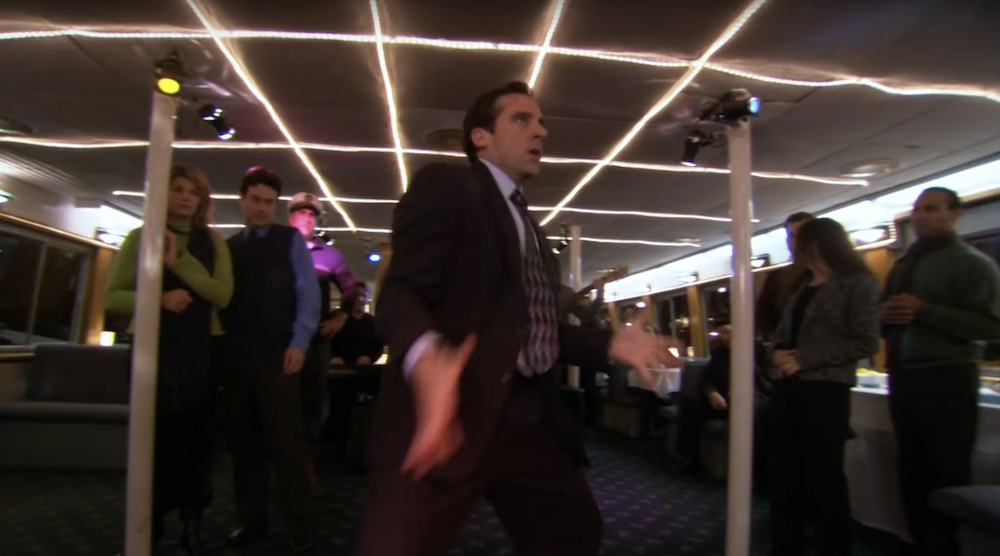Can dancing more make you a better worker?

Can dancing more boost your productivity? | Screencap from “Michael Scott’s Awkward Dancing” on The Office/YouTube
Fictional characters randomly breaking into dance has always been such a trip to watch. Well, especially when it’s in one of the most unlikely territories—the workplace.
There’s Jenna Rink attempting a “Thriller” choreography during a company party in “13 Going On 30,” Captain Holt and Terry’s random moves during a critical situation in “Brooklyn Nine-Nine,” and many “The Office” random dance scenes, with a special shoutout to Michael Scott’s unhinged cruise ship performance (that’s supposed to be teaching some important lessons).

While any sudden waltzing or aggressive turning can warrant an office memo in real life, it can also be understandable why an employee may just have the urge to dance in a fast-paced (and high-pressure) environment.
After all, the art is known to boost the brain and improve physical health, among others. But get this: Dancing might just be your answer to amping up your productivity, too.
Can dancing answer our productivity problem at work?
This topic was given the spotlight in the study by Michela Vecchi, Patrick Elf, Akiko Ueno, Athina Dilmperi, Charles Dennis, and Luke Devereux published in the Journal of International Marketing.
Titled “Shall We Dance? Recreational Dance, Well-Being, and Productivity Performance During COVID-19: A Three-Country Study,” which was first published in Jan. 2022, this academic effort zeroed in on dancers and non-dancers (but actively exercise) from Italy, United Kingdom, and Brazil to compare their performance in the workplace.
Utilizing questions from the World Health Organization’s Health and Work Performance Questionnaire, the researchers surveyed these workers based on their absenteeism (which according to professors Vecchi and Ian Marsh’s The Conversation article, means “not turning up to work”) and presenteeism (“not working as hard as usual when at work”).
“For a more meaningful comparison of productivity performance, we matched each dancer with a non-dancer with similar personal and job characteristics. This way, the only observable difference between the matched participants is how they exercise. So, any differences in productivity could be due to dance,” the article said.
“So, our results could simply indicate that dance improves [well-being], and [well-being] leads to higher productivity, rather than dance improving productivity directly”
Dissecting these, the researchers discovered that both presenteeism and absenteeism are lower with dancers versus non-dancers.
The article further mentioned the already existing studies that deep-dived into the relationship between well-being and performance, and dance and well-being.
“So, our results could simply indicate that dance improves [well-being], and [well-being] leads to higher productivity, rather than dance improving productivity directly,” it indicated.
Because of this, it was a must that they analyze side by side “dancers and non-dancers who match in terms of other personal and job characteristics” but carry the same levels of well-being. The result? Dancers still prove to have better performance at work.
“This suggests that the positive correlation between dance and productivity goes beyond the well-known [well-being] effects. Dance has a direct effect on worker productivity, it’s not just making dancers feel happier,” they revealed.
“Dancing has an additional direct effect on productivity, beyond the mediating role of SWB (subjective well-being),” the authors wrote in the study’s abstract.
With that being said, the researchers also brought up the possible positive effects of integrating recreational dance into workplace programs. As they further probed, they also noticed that “the productivity-enhancing effect of dance is also stronger in activities involving high levels of teamwork.”
Doing viral TikTok dances: An effective work break?
Speaking of dancing in the workplace, you’ll know that this isn’t a foreign concept when you do some doomscrolling on TikTok. Construction sites, corporate offices, fast food chains—you can catch employees joining the Gen Z-centric platform’s dance trends in their uniforms. In the Philippines, a security guard even went viral because of this. While not everyone sees this as a good idea, is it possible that these brief moments of moving have been improving these employees’ approach to work—both in building relationships and producing more quality output?

